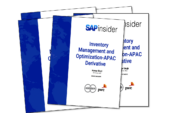Market Insights
The number of solutions available from SAP and their broader partner ecosystem is more than most SAPinsiders have the time to learn about or understand, let alone implement. To help provide the information you need on why the topics that these solutions address are important, SAPinsider’s skilled team of analysts and editors interview organizations to learn more about the solutions they offer and the business challenges they address. These articles explain current trends around these topics, how vendors are addressing them, and what you can do to prepare your own organization.
60 results
-

A Discussion on Thomson Reuters’ Approach to Tax Management
Reading time: 2 mins
Thomson Reuters’ SVP Ray Grove outlined a compliance strategy focused on embedding tax processes into business operations, enhancing connectivity between systems, and utilizing data-driven insights to navigate the increasingly complex regulatory landscape.
-

Thriving in a Shifting Technological Landscape with BlackLine CIO Sumit Johar
Reading time: 5 mins
SAP organizations around the world are faced with a technological landscape that is growing and shifting more rapidly than ever before. CIOs are tasked with understanding the capabilities that AI, automation, cloud computing, digital transformation, and more offer to their organizations. To help companies maximize their business process transformations, SAPinsider sat down with BlackLine CIO…
-

- SAP AI
 Premium
Premium
Even Oprah Has an AI Strategy: AI Hype vs Reality and What it Means for You
Reading time: 3 mins
Unless you have been living under a rock, you have been exposed to the tremendous coverage and hype around artificial intelligence (AI) and machine learning. You know when Oprah Winfrey is dedicating an hour-long show to discuss this trend that it has hit not just business and IT circles, but the mainstream media and consumer...…
-
-

How to Rate the Criticality of Your Equipment
Reading time: 2 mins
Rating equipment criticality is an important part of a strong preventive maintenance plan. By giving your equipment a rating and setting up guidance rules, you can ensure that your maintenance and engineering efforts are focused in the correct areas.
-

The Differences in Permitting and Safety Lexicon by Region
Reading time: 5 mins
If you’re a global company with facilities in different countries and regions, you already know that there are different lexical differences in discussing health and safety in various places around the world.
-

The Study: Transformation 2023
Reading time: 1 min
Gain insights from 600+ companies in 9 countries on their successful IT transformation journeys. Learn from their experiences and avoid pitfalls.
-

TJC Group- How SAP Data Volume Management Contributes to Sustainability
Reading time: 1 min
Did you know data, growing at exponential rates, is one of IT’s hidden polluters? Today the digital economy accounts for 3 to 4% of the worldwide greenhouse gas emissions1. Is your organisation committed to reducing its carbon footprint? Find out how to keep your business sustainable in 2023. Download this Ebook to find out ways to reduce…
-
-

IPS Accounts Payable Ariba/Business Network Integration
Reading time: 1 min
IPS is your trusted partner for your path to digitization of your AP processes. We have helped hundreds of companies digitize their AP processes, and we can help you too. Download this brochure to understand how organizations can streamline and accelerate the Invoice-to-pay process and provide users with real-time visibility into status and digitally introduce...…
-

Advancing Enterprise Integration is a Mission Critical Priority
Reading time: 1 min
Enterprise integration is a top priority for CIOs, with 83% saying it’s a top-five business priority. However, only 27% of organisations report having a mature enterprise integration practice, with 55% in the process of pivoting towards it. To drive a shift towards a more holistic approach, 53% of organisations have created a dedicated team to…
-

- SAP Inventory Management
 Premium
Premium
Inventory Management and Optimization Research- APAC Derivative
Reading time: 1 mins
Inventory management challenges and supply chain risks are growing exponentially as businesses try to manage the complexities presented by globalization. These challenges surface in unprecedented fluctuations in demand and supply, inventory policies and delivery systems diversity, and geopolitical and regulatory changes. These have only intensified during the pandemic. Unsurprisingly, in SAPinsiders’s recent research, Supply Chain…
Become a Member
Unlimited access to thousands of resources for SAP-specific expertise that can only be found here.
Become a Partner
Access exclusive SAP insights, expert marketing strategies, and high-value services including research reports, webinars, and buyers' guides, all designed to boost your campaign ROI by up to 50% within the SAP ecosystem.
Upcoming Events
Related Vendors
Your request has been successfully sent


